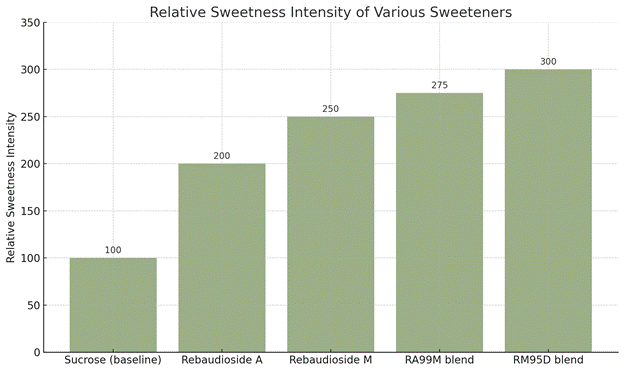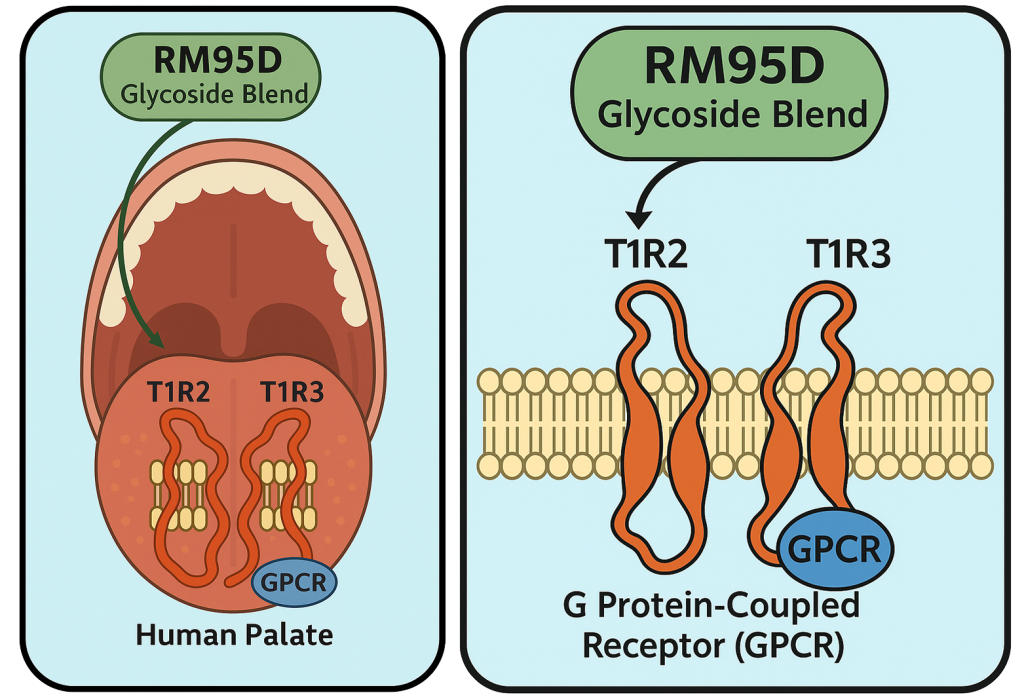In today’s fast-paced world, where health and wellness are at the forefront of consumer choices, the pursuit of sugar alternatives has led to exciting innovations in the food industry. One such innovation is Icon Foods’ SteviaSweet™ RM95D, a remarkable blend of steviol glycosides featuring rebaudioside M (commonly referred to as Reb M) and rebaudioside D (known as Reb D). This blend is available in both conventional and organic forms, making it a popular choice among those looking to create better-for-you foods and beverages, especially for individuals who wish to indulge in sweetness without the added sugars.
Understanding Steviol Glycosides
To grasp why SteviaSweet™ RM95D is so effective, it’s essential to understand steviol glycosides. These naturally occurring compounds are extracted from the leaves of the Stevia rebaudiana plant, a traditional source of sweetness that has been utilized for centuries in various cultures. Unlike conventional table sugar, which can lead to increased calorie intake and rapid spikes in blood glucose levels, steviol glycosides provide a sweet flavor without the caloric burden or high glycemic impact. This unique characteristic makes them a favored option for individuals seeking to cut back on sugar while still satisfying their cravings for sweetness.

The above chart illustrates the sweetness perception of:
- Rebaudioside M – delivers high sweetness with a smooth, sucrose-like onset.
- Rebaudioside D – has a slightly earlier onset but lower sweetness intensity and a flatter curve.
- RM95D Blend – combines the best of both, yielding an optimized curve with enhanced sweetness intensity, smoother onset, and reduced bitterness compared to either component alone.
The Synergy of Rebaudioside M and Rebaudioside D
So, what truly sets SteviaSweet™ RM95D apart from other sweeteners? The answer lies in the harmonious combination of its key components. Rebaudioside M is celebrated for its exceptionally clean and sweet flavor profile, often described as smooth and pleasant on the palate. In contrast, rebaudioside D, while slightly less sweet than Reb M, contributes a distinctive depth and richness to the overall sweetness experience. Together, these two compounds create a well-rounded blend that enhances the flavor of various food and beverage products without the bitter aftertaste that can accompany many artificial sweeteners.
This combination allows manufacturers to formulate products that not only taste delightful but also provide a healthier alternative, making it easier for consumers to enjoy nutritious options without sacrificing flavor.

Above is a bar chart comparing the relative sweetness intensity of:
- Sucrose (baseline at 100)
- Rebaudioside A (~200)
- Rebaudioside M (~250)
- RA99M blend (~275), optimized for maximum sweetness with minimal bitterness
- RM95D blend (~300), optimized for maximum sweetness with minimal bitterness
Perfect for Low- to No-Added-Sugar Formulations
One of the standout features of SteviaSweet™ RM95D is its compatibility with products designed to minimize added sugars. Here’s how it excels in the formulation of better-for-you foods and beverages:
- Caloric Control: RM95D empowers food manufacturers to create sweetened products without the additional calories typically associated with regular sugar. This is particularly advantageous for individuals who are carefully monitoring their caloric intake or those on a weight-loss journey.
- Blood Sugar Management: For those managing diabetes or anyone focused on maintaining stable blood sugar levels, RM95D offers a sweet solution that does not trigger significant increases in glucose levels. This makes it a safe and appealing choice for a broad spectrum of consumers.
- Versatile Applications: The RM95D blend is remarkably versatile, proving effective in a wide range of formulations—from refreshing beverages to baked goods and even savory sauces. This adaptability allows food developers to experiment creatively while meeting the growing consumer demand for healthier alternatives.
- Availability in Organic and Conventional Forms: The availability of both conventional and organic options for RM95D caters to the diverse preferences of today’s consumers. As the trend toward organic products continues to gain traction, offering this choice can significantly enhance a brand’s appeal to health-conscious shoppers.
- Clean Label Appeal: Modern consumers increasingly prioritize transparency regarding the ingredients in their food. Since RM95D is derived from a natural source—the stevia plant—it aligns seamlessly with the “clean label” movement that many brands are embracing. This commitment to transparency helps build consumer trust and loyalty.
Best Practices and Ideal Applications for SteviaSweet™ RM95D
SteviaSweet™ RM95D is ideal for food and beverage applications where deep, clean-label sugar reductions(40-70%) are required without compromising taste, particularly in formulations that cannot tolerate off-notes or require a clean sweetness curve. Its best-fit applications include:
Beverages
- Carbonated Soft Drinks: Delivers a sugar-like sweetness curve with no bitter tail, essential for low- and no-calorie sodas.
- Functional & Nootropic Beverages: Works well with adaptogens, amino acids, and electrolytes where other sweeteners amplify off-notes.
- Ready-to-Drink Teas & Coffees: Enhances perceived sweetness while maintaining clean-label appeal.
- Juice Blends & Flavored Waters: Allows for deep sugar cuts while preserving the bright, crisp taste profile.
Snacks & Confections
- No-Added-Sugar Chocolate: Complements the bitterness of cacao without introducing metallic or lingering notes.
- Chewy Candies & Gummies: Supports texture and sweetness balance when combined with polyols or fibers like allulose or IMO(isomaltooligosaccharides). Covers the off notes of terpenes.
- Protein Bars & Functional Snacks: Masks bitterness from protein isolates while reducing the glycemic load.
Dairy & Plant-Based Alternatives
- Yogurts (Dairy or Almond/Coconut/Cashew-based): RM95D balances tartness while cutting added sugar.
- Flavored Milks & Milk Alternatives: Maintains flavor while meeting sugar targets in school or clinical nutrition applications.
- Frozen Desserts (Ice Cream, Sorbet, Nice Cream): Allows for deep sugar reductions while preserving sweetness in cold matrixes.
Condiments & Sauces
- Ketchup, BBQ, Teriyaki, Salad Dressings: Maintains front-end sweetness without bitterness in acidic, savory bases.
Sweet Baked Goods
- Muffins, Cakes, Breads: Performs well with bulking agents (e.g., allulose, soluble tapioca fiber) for structural integrity and sweetness.
- Cookies & Biscuits: Supports clean-label positioning in reduced-sugar formulations without flavor compromise.
Why It Works:
SteviaSweet™ RM95D’s synergy of Reb M and Reb D targets the T1R2/T1R3 taste receptors with high fidelity, providing a clean, sugar-like taste ideal for applications where consumer experience and label transparency are paramount. It’s particularly effective when paired with small amounts of sugar, allulose, erythritol, or fibers to create a balanced sweetness and full-bodied mouthfeel.
The Science Behind SteviaSweet™ RM95D and Positive Allosteric Modulation
SteviaSweet™ RM95D acts as a sweetness modulator, also known as a positive allosteric modulator, primarily due to its composition of Reb M and Reb D, both of which interact with the sweet taste receptors located on the tongue and palate. Understanding how RM95D influences sweetness perception involves delving into the science of taste receptor activation and the unique properties of these steviol glycosides.
Mechanism of Action
Sweet Taste Receptors:
- The human tongue is equipped with taste buds that house specialized cells known as taste receptor cells. These cells express sweet taste receptors, specifically the T1R2 and T1R3 receptors, which belong to the G protein-coupled receptor (GPCR) family. When a sweet substance binds to these receptors, it triggers a signaling cascade that ultimately leads to the perception of sweetness.

Binding and Activation:
- RM95D, containing both Reb M and Reb D, binds to the T1R2/T1R3 receptor complex present on the taste receptor cells. Reb M is known for its potent sweetness, which can be several hundred times sweeter than sucrose, while Reb D, although slightly less sweet, offers a distinct flavor profile that contributes to the overall sweetness experience. The combination of these two compounds allows for a more nuanced activation of the sweet receptors, enhancing sweetness perception while minimizing any potential bitterness.
Sweetness Modulation:
- The term “sweetness modulation” refers to the ability of certain sweeteners to not only provide sweetness but also to modify or enhance the perception of sweetness in a formulation. SteviaSweet™ RM95D functions as a sweetness modulator by influencing the activation of taste receptors in a way that amplifies the sweet taste without the necessity for high concentrations of sugar. This is particularly advantageous in products targeting low to no added sugar, as it allows for achieving desirable sweetness levels without excessive caloric content.
Scientific Features That Enhance Sweetness Modulation
Sugar’s Best Friend:
- SteviaSweet™ RM95D is sugar’s best friend in clean label formulation because it doesn’t compete with sugar—it complements it. Its balanced blend of high-purity rebaudioside M and D glycosides provides a rounded sweetness profile that mirrors the onset, intensity, and dissipation of sucrose without the bitter tail or metallic notes often associated with first-generation stevia. This makes it an ideal sweetness modulator in reduced-sugar formulations where sugar is partially retained for bulking, browning, or mouthfeel, but overall load must be lowered for health or regulatory reasons. By enhancing sucrose’s sensory perception, SteviaSweet™ RM95D allows formulators to achieve up to 50% sugar reduction without sacrificing taste integrity, making it a go-to tool in natural, better-for-you applications.
Synergistic Effects:
- The blend of Reb M and Reb D in SteviaSweet™ RM95D creates a synergistic effect that enhances sweetness perception. This synergy can lead to a more complex and satisfying flavor profile, making it appealing to consumers who may be sensitive to or dissatisfied with the taste of other sweeteners.
Reduced Bitter Aftertaste:
- Many non-nutritive sweeteners are known to produce a bitter aftertaste. However, RM95D’s specific combination of Reb M and Reb D helps mask or minimize these undesirable flavors. This results in a cleaner, more pleasant taste experience, which is crucial for consumer acceptance.
Low Glycemic Index:
- Unlike sucrose and other saccharides, SteviaSweet™ RM95D has a negligible impact on blood glucose levels. This characteristic is essential for consumers aiming to lower their sugar intake for health reasons, such as managing diabetes or weight control, while still enjoying sweet flavors.
Icon Foods’ SteviaSweet™ RM95D serves as an effective sweetness modulator through its interaction with the sweet taste receptors on the tongue and palate. By combining rebaudioside M and rebaudioside D, this blend enhances sweetness perception, offers a balanced flavor profile, and reduces the potential for bitterness—all while maintaining a low caloric impact. This makes RM95D an ideal choice for formulating better-for-you foods and beverages, catering to the growing demand for healthier alternatives that do not compromise on taste. As food scientists and manufacturers continue to explore the possibilities of sweetness modulation, RM95D stands out as a promising ingredient for the future of food and beverage development.
SteviaSweet™ RM95D by Icon Foods is an ideal choice for formulating better-for-you foods and beverages, catering to the growing demand for healthier alternatives without compromising on taste.
Since 1999 Icon Foods has been your reliable supply chain partner for sweeteners, fibers, sweetening systems, inclusions and sweetness modulators.
Reach out to your Icon Foods representative for SteviaSweet™ RM95D samples, documentation and formulations guidance.
Request a Sample of RM95D Today and Taste the Icon difference.